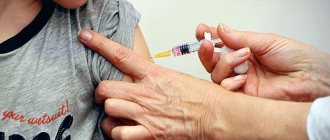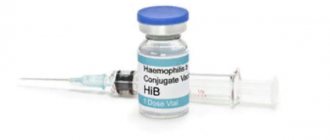Rotavirus infection is a very common disease in young children. Outbreaks of morbidity occur especially often in preschool institutions, at public events and on vacation by the sea (usually the Black Sea, which is associated with the construction of treatment facilities at our resorts). Like many other intestinal infections, it is transmitted primarily through the fecal-oral and household contact routes, through food and water, and also by airborne droplets from person to person. The virus remains alive on surfaces for a long time and is not susceptible to all antiseptics.
Rotavirus is dangerous for children because it causes gastroenteritis, inflammation of the stomach and small intestine, manifested by severe vomiting and diarrhea. This leads to electrolyte imbalance and rapid dehydration, and the younger the child, the faster it occurs. In severe cases, this may lead to hospitalization; most often they occur between the ages of 6 months and 2 years.
It is possible and necessary to protect your child from the most common serotypes of rotavirus. The Rotatek vaccine is not included in the National Preventive Vaccination Calendar, so not all parents know about it. At the same time, Rotatek is one of the few vaccines that have strict age restrictions for use: the baby should receive the first dose between 6 and 12 weeks, the last dose no later than 32 weeks (about 8 months). The interval between doses (there are three in total) should be from 4 to 10 weeks.
Vaccine options
Current vaccines are based on the production of live attenuated strains of rotavirus of human and/or animal origin that multiply in the human intestine.
There are two rotavirus vaccines on the international market: monovalent (RV1 - Rotarix) and pentavalent (RV5 - RotaTek). The RV1 vaccine is based on a human strain, while the RV5 vaccine contains 5 recombinant viruses based on human and bovine strains. In Russia, the RotaTek vaccine (pentavalent RV5) is used - it is oral and contains 5 recombinants of rotaviruses obtained from human and bovine parent strains of the virus. The interchangeability of RV1 and RV5 vaccines has not been studied.
Vaccination scheme
Three doses of the vaccine are administered. The first dose of the RotaTek vaccine should be administered as soon as possible after the child reaches the age of 1.5 months (6 weeks). Subsequent doses are given 4 to 10 weeks apart, with the final dose of vaccine given before the child reaches 32 weeks (8 months) of age.
Standard recommended RotaTek vaccination schedule: 2-3-4.5 months.
The RotaTek vaccine can be used in premature babies born at at least 25 weeks of gestation. The vaccine should be administered to such children no earlier than 6 weeks after birth.
Principles and purposes of vaccination
Rotaviruses infect almost every child before they reach the age of 3-5 years and are the world's leading cause of severe diarrhea with dehydration in children aged 3-5 years. Every year in the period before the introduction of the vaccine (1986-2000), more than 2 million children around the world were hospitalized for rotavirus infection. WHO estimates that in 2008 there were approximately 453 000 (420 000 – 494 000) deaths among children associated with rotavirus gastroenteritis (RVGE) worldwide.
Currently, there is no specific therapy for rotavirus infection. WHO recommends that rotavirus vaccines should be included in national immunization programs and considered as a priority, especially in countries with high mortality rates associated with RVGE, such as countries in South and Southeast Asia and sub-Saharan Africa. The use of rotavirus vaccines should be a component of a comprehensive strategy to control diarrheal diseases. By the end of 2013, rotavirus vaccine had been introduced in 52 countries, and vaccine coverage had reached 14%.
The first dose of rotavirus vaccine, according to WHO recommendations, should be administered as early as possible - when the child reaches 6 weeks of age. The RV1 vaccine must be given twice, and the RV5 vaccine must be given three times. Both vaccines are given orally, with at least 4 weeks between doses. The RotaTek vaccine can be administered on the same day with any other vaccines (DPT, inactivated polio vaccine, vaccines against Haemophilus influenzae and pneumococcal infections, etc.) except oral live polio vaccine.
RotaTek, oral solution, 2 ml, 10 pcs.
According to clinical studies, the vaccine virus was detected in the stool of 8.9% of vaccinated children only within 1 week after the first dose of the vaccine and only in 0.3% of children (1 case) after the 3rd dose. According to post-registration data, transmission of the vaccine virus to unvaccinated individuals is possible. The RotaTek vaccine should be administered with caution to children who are in close contact with people with immunodeficiency (including cancer, immunocompromised people or people receiving immunosuppressive therapy). Special hygiene rules should be observed when coming into contact with the feces of a vaccinated child.
There are no data on the effectiveness and safety of the RotaTek vaccine in children with compromised immunity, children with asymptomatic HIV infection, or children who received a blood transfusion or immunoglobulins no more than 42 days before the vaccine was administered. Asymptomatic HIV infection (HIV carriage) is unlikely to affect the safety and effectiveness of the RotaTek vaccine. However, due to insufficient clinical data, the use of the RotaTek vaccine for asymptomatic HIV infection is not recommended.
Cases of gastroenteritis caused by rotavirus strains included in the vaccine have been reported in children with severe combined immunodeficiency.
In a clinical study, RotaTek vaccine was administered to approximately 1,000 infants born at 25 to 36 weeks' gestation, with the first dose administered at 6 weeks after birth. The effectiveness of the RotaTek vaccine in this subgroup did not differ from the subgroup of children born at term. However, among these 1,000 babies, 19 were born between 25 and 28 weeks of gestation, 55 were born between 29 and 31 weeks, and the rest were born between 32 and 36 weeks.
According to clinical studies, the risk of intussusception in the group of patients receiving the RotaTek vaccine was comparable to the risk in the placebo group. However, within 31 days after the first dose of RotaTek vaccine and especially during the first 7 days, a slight increase in the risk of intussusception cannot be excluded. In this regard, you should carefully monitor the appearance of symptoms characteristic of this disease: acute abdominal pain, uncontrollable vomiting, blood in the stool, bloating, fever, and immediately seek medical help if they occur.
The specified level of protection after vaccination with RotaTek is ensured with a completed vaccination course consisting of 3 doses. Like any other vaccine, RotaTek cannot provide complete protection to all vaccinated people. The RotaTek vaccine is effective only against rotavirus infection and does not protect against gastroenteritis caused by other pathogenic microorganisms.
Clinical studies of the effectiveness of protection against rotavirus gastroenteritis were conducted in Europe, the USA, Latin America and Asia. At the time of these clinical studies, the most common rotavirus genotype was G1P[8], while the remaining genotypes G2P[4], G3P[8], G4P[8] and G9P[8] were found less frequently. The level of protection that RotaTek vaccine provides against other types of rotaviruses and in other populations is unknown.
There are no data from clinical studies on the use of the RotaTek vaccine for prevention after contact with a patient with rotavirus gastroenteritis.
When deciding whether to vaccinate a child with severe prematurity (≤28 weeks' gestation, but not less than 25 weeks' gestation), especially one with a history of respiratory immaturity, it is necessary to take into account the fact that the benefit of immunization against rotavirus infection in this group of patients is high and should not be neither refuse vaccination nor reschedule it. However, given the potential risk of apnea, it is preferable to carry out the first vaccination of a premature infant in a hospital setting with the possibility of medical observation of the patient’s condition for 48-72 hours.
Because in the production of reassortants included in the RotaTek vaccine, biological material of animal origin is used; small DNA fragments of porcine circovirus types 1 and 2 (PCV-1 and PCV-2) were found in the vaccine, while the viral particles themselves PCV-1 and/or PCV -2 are absent in the vaccine. The ability of PCV1 and/or PCV2 to cause disease in humans is not known.
RotaTec should be administered as soon as possible after removal from the refrigerator.
The drug can be used after removal from the refrigerator for 48 hours, provided that it was stored at a temperature not exceeding 25°C. If the vaccine package is not used within the specified time, it must be disposed of.
Use in pediatrics
RotaTek vaccine is generally well tolerated and highly effective in preventing rotavirus gastroenteritis when used in children 6 to 32 weeks of age.
Efficacy and safety have not been established in children less than 6 weeks of age.
Impact on the ability to drive vehicles and operate machinery
Not applicable.
Vaccine effectiveness
WHO recommends preventive vaccination as an effective remedy against rotavirus. Current vaccines demonstrate 80–90% effectiveness against severe rotavirus gastroenteritis (RVGE) in countries with very low or low mortality rates in children and adults, and 40–60% effectiveness in countries with high mortality rates in children and adults. high or very high mortality rates among adults. In developed countries, a decrease in the incidence of RVGE was observed several years after immunization. In Mexico and Brazil, vaccination resulted in a 22% to 28% reduction in diarrhea-related deaths among children 2 years of age and younger.
In most cases, vaccination in infancy provides protection against severe RVGE for at least 2 years (the period of greatest risk).
Infants can receive rotavirus vaccine along with DTP, regardless of the time of vaccination. Rotavirus vaccinations for children over 2 years of age are not considered inappropriate. Rotavirus vaccines may be given at the same time as other routine childhood vaccines except live oral polio vaccine.
Advantages of the RotaTek vaccine
- The RotaTek vaccine does not contain thiomersal or other preservatives.
- It is administered orally (through the mouth), no injections are required, which is important for young children.
- The only vaccine to protect against five common types of rotavirus at once: G1, G2, G3, G4 and G9.
- 74.5% effectiveness against mild, moderate and severe forms of rotavirus infection.
- 95% reduction in hospitalizations due to rotavirus infections.
- Reducing the severity of rotavirus gastroenteritis if the disease develops 14 days after the first vaccination.
Contraindications
The main contraindications for vaccination against rotavirus infection are a severe allergic reaction to the previous dose and severe immunodeficiency. Cautions for the use of rotavirus vaccine include a history of intussusception or intestinal malformations, chronic gastrointestinal diseases, and acute severe illness. Vaccination should be postponed if the child has acute gastroenteritis or fever due to severe or moderate illness.
After the end of the incubation period of the disease, the following symptoms of the disease develop:
- General intoxication: increased body temperature, chills, weakness, headache, dizziness.
- Gastroenteritis: repeated vomiting, abdominal pain, frequent watery foamy stools, flatulence.
- Catarrhal symptoms: redness of the mucous membrane of the oropharynx, sore throat.
The disease can begin either with an increase in body temperature or with repeated vomiting and liquid diarrhea. The child's temperature usually rises to 38-39 degrees Celsius.
If the course of the disease is favorable, its duration is usually 5-7 days. However, in some cases, especially in young children and adults with poor health, various complications may develop.
What side effects may there be?
Despite the fact that Rotatec is most often well tolerated, side effects are sometimes observed during vaccination. Among them:
loss of appetite;- apathy;
- excessive sleepiness;
- rashes on the skin;
- loose stool;
- hyperthermia.
If such symptoms appear, you need to carefully monitor the baby’s condition.
If you notice a deterioration in your health, and side effects become pronounced, you need to seek help from a doctor..
Possible complications
In the post-vaccination period, serious complications may develop. They are observed with contraindications to vaccination.
In this case, the following negative changes may be observed:
severe forms of allergic reaction;- gagging, causing dehydration;
- intussusception;
- volvulus;
- formation of ulcers and erosion;
- internal bleeding.
Compatibility with other vaccines
The compatibility with other vaccines of the Rotatec drug deserves special attention. It can be administered simultaneously with almost all drugs included in the vaccination calendar.
Simultaneous use with medications that protect against the following diseases is allowed:
tetanus;- rubella;
- Hib infection;
- diphtheria;
- meningococcal infection;
- hepatitis B virus;
- mumps;
- measles;
- pneumococcal infection.
Rotatek is also compatible with pertussis vaccines, but only those containing acellular virus. It is not used with whole cell preparations.
Simultaneous use with inactivated polio vaccinations is allowed.
Rotatec cannot be combined with oral live polio vaccine. The interaction of these medications has not been fully studied. This combination is thought to reduce the immune response to rotavirus.
Side effects
Before vaccination, the patient is examined by a doctor to rule out any contraindications. This allows you to minimize the occurrence of adverse reactions.
The most common complications are:
- infectious diseases of the upper respiratory tract;
- fever;
- stomach ache;
- intestinal obstruction;
- nausea, vomiting;
- diarrhea;
- skin rash;
- bronchospasm.
Additional Information
The risk of intestinal obstruction or intussusception, when one part of the intestine is inserted into another, was assessed by specialists in a placebo-controlled study. Within 42 days after vaccination, the appearance of this complication was recorded in 6 vaccinated people and in 5 patients who received a placebo instead of the drug. Thus, the relationship between the use of Rotatec and the development of intestinal obstruction was not confirmed.
Special patient groups
In children suffering from immunodeficiency conditions, symptoms of gastroenteritis were identified, which was provoked by the strains included in the vaccine. Premature babies may develop a dangerous complication - apnea.
Preparing for vaccination
No special preparation is required for the procedure.
It is enough to show the child to the doctor on the day of vaccination. The pediatrician assesses his condition, excludes possible contraindications and decides on the possibility of immunization .
After administration of the drug, children should not be restricted in drinking and eating. There is no need to force feed the baby or introduce new foods to the menu.
Expert opinion
Nikolaeva Elena Sergeevna
Practicing pediatrician.
Ask a Question
During the post-vaccination period, it is not prohibited to walk in the fresh air if weather conditions permit. The main thing is to avoid crowded places.
If your child is prone to allergies, you should discuss with your pediatrician the need to take antihistamines. The doctor selects the medication on an individual basis.
Vaccination scheme
The procedure is quite simple and does not cause difficulties:
The ampoule with the solution is opened.- The child opens his mouth.
- The drug is administered behind the cheek.
Immediately after completing these steps, parents and their baby should go home. There are no restrictions on swimming and walking during the post-vaccination period.
The scheme is as follows:
- the product is first instilled at 6-12 weeks;
- up to 32 weeks the full course of vaccinations is completed;
- In total, the drug is administered three times.
pharmachologic effect
Rotavirus causes severe development of acute gastroenteritis in infants and young children. By the time a child reaches 5 years of age, he is more likely to suffer from this disease, regardless of living conditions and environmental conditions. In this age period, rotavirus infection occurs in 95% of children. In hot climates, rotavirus gastroenteritis causes seasonal outbreaks during the winter months. Rotavirus is one of the main reasons for hospitalization of children with signs of acute diarrhea.
The Rotatech vaccine includes the most common serotypes of human rotavirus: P1, G1, G2, G3, G4. They caused rotavirus infection from 1973 to 2003 in the world. The exact immunological mechanism of protection could not be described. Experts suggest the presence of several factors, including the neutralization of antibodies to capsid proteins G. The drug causes the growth of antibodies that negatively affect common serotypes.
Contraindications for Rotatek vaccination
Contraindications to immunization include:
- acute poisoning;
- diarrhea;
- disorders of the gastrointestinal tract;
- intestinal obstruction;
- individual intolerance to the components included in the drug;
- elevated temperature;
- colds;
- recovery from a cold;
- tendency to exhibit allergic reactions;
- congenital anomalies of the gastrointestinal tract structure;
- HIV infections;
- immunodeficiency.
Vaccination is carried out with caution in the following cases;
- the presence of gastrointestinal pathologies that occur in a chronic form;
- psychomotor and neurological disorders;
- recent blood transfusion;
- diseases affecting the immune system.
Vaccination schedule
An approximate immunization schedule looks like the following:
- at 3, 4 and 6 months;
- at 2, 3 and 5 months;
- at 6, 14 and 22 weeks (if early protection is needed).
After 15 weeks, the first dose is not recommended. If there is an urgent need for immunization, only two doses are administered, maintaining an interval of a month.
The duration of the vaccination largely depends on the individual characteristics of the body and varies from two to three years.
When and how to vaccinate
Despite the fact that RotaTech is not included in the list of mandatory vaccinations approved by the National Calendar, pediatricians advise vaccination with drugs that create additional protection for a fragile body.
The optimal age for vaccination is the first 6 months of a baby’s life. However, sometimes it is carried out even after a year. The use of the vaccine for children over 5 years of age is ineffective, since by this time the child’s body will have already formed immunity.
The vaccine is not given as a shot. The contents of the individual packaging should reach the inside of the cheek. Even if the baby spits out the liquid or burps, the drug does not need to be re-administered.
Efficiency
The vaccine is aimed at forming reliable protection against the causative agent of rotavirus infection. According to the results of clinical trials, the disease-causing ability of serotypes G is suppressed by more than 70%. The effectiveness of protection against severe gastroenteritis during the first season when outbreaks are observed is more than 98%.
The degree of protection against gastroenteritis caused by serotype G9, which is not included in the vaccine, is also high - 74.1%. Rotatek® reduces the number of hospitalizations of children with severe diarrhea and other manifestations of rotavirus infection.
Experts know the data on the effectiveness and safety of the vaccine when used in premature infants. A placebo-controlled study was conducted in which 1007 newborns took part in the age period of 25-36 weeks. They were vaccinated with the drug Rotatec. And the results regarding efficacy and safety did not differ from data obtained in other age groups in which subjects were born at term.





